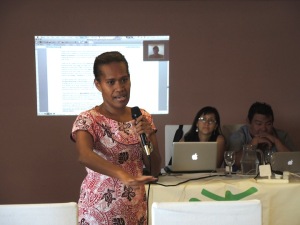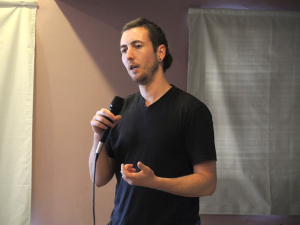By Anne Petermann, Executive Director, Global Justice Ecology Project, 20 November 2014
Global Justice Ecology Project is in Paraguay for two weeks of meetings to strategize means to address the impacts of wood-based bioenergy, genetically engineered trees and livestock on deforestation levels, and the solutions to the climate change and deforestation crisis provided by local communities maintaining and caring for their traditional lands.

Aydah from the Solomon Islands speaks at the meeting. If biomass energy is not stopped, her islands will continue to drown. Photo credit: GJEP-GFC
Today’s meetings included the participation of activists from throughout Africa, Asia, the South Pacific, North and South America and Eastern and Western Europe. The topic at hand was the problem of wood-based bioenergy–specifically electricity derived from cutting down forests, destroying biodiversity, polluting the atmosphere and displacing forest-based Indigenous and local communities.
Biomass also comes with an enormous cost in waste. In the Drax UK biomass plant, Biofuelwatch has calculated that of every three trees burned, two are wasted as heat. Half of one UK power station takes more wood than the entire UK produces every year and supplies only 4.6% of the country’s electricity demand. These power stations require co-generation with coal, so increased use of biomass = increased use of coal. Without the biomass conversion, this Drax plant would have had to close by 2016. The conversion to co-generation with biomass is allowing it to stay open, enabling continued and increased use of coal.
Defining this dirty wasteful, ecologically destructive and socially unjust energy as “renewable” drives increased biomass electricity generation by legitimizing it as a supposedly eco and climate-friendly technology. It also allows them to be eligible for renewable energy subsidies to the tune of £730 million per year ($1.1 billion/yr) The total cost of converting the plant to biomass was only conversion cost was £700 million.

Oli from Biofuelwatch in the UK describes the problems of the Drax biomass plant during the meeting. Photo credit: GJEP-GFC
Drax requires slow growing trees with low bark content. This means whole logs from wetland native forests in the Southern US, plus more from British Columbia. It is driving massive increases in deforestation for wood pellet exports from the US. In the Southern US, 75% of wetlands are forested. These forests are some of the most biodiverse in North America with many rare and endangered species. The amount of wood coming out of these forests for wood pellets to be shipped overseas doubled from 2012 to 2013.
There are twenty wood pellet manufacturing facilities in the US South now and 33 proposed or under construction. There continues to be much uncertainty, however, about the feasibility of new biomass facilities, and spurred by lawsuits and opposition, investors are wary and numerous proposed biomass plants have been scrapped.
These are the situations and critical issues we will continue to grapple with tomorrow.
